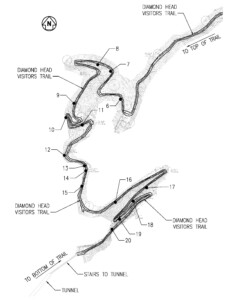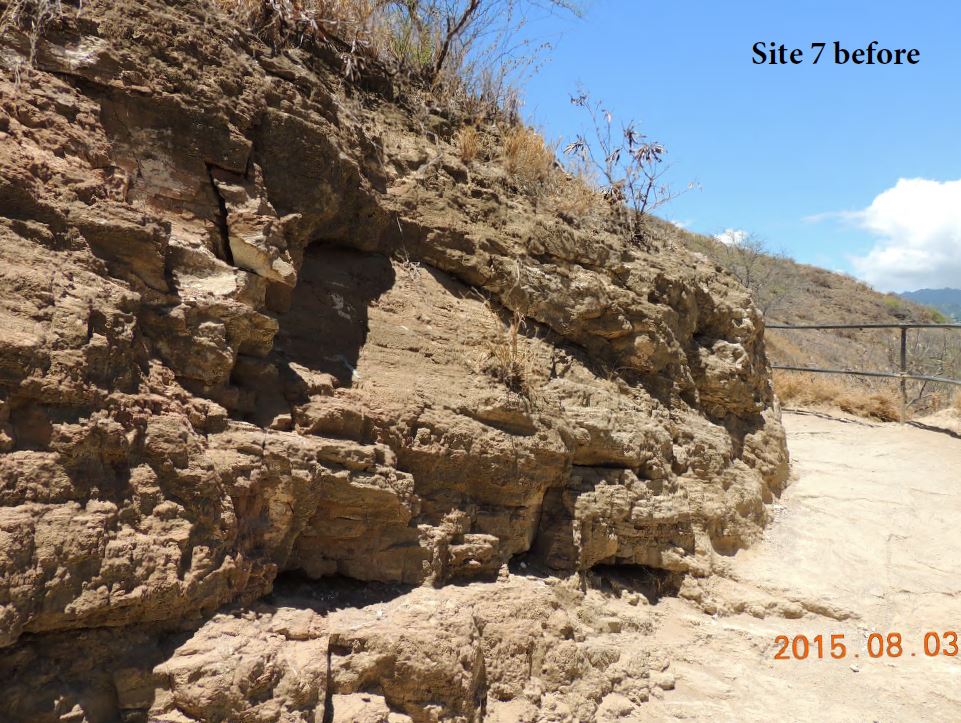Who would ever think fabricated rock would be eligible to receive a preservation award? This was the facetious question that crossed my mind as I headed out with my fellow Preservation Awards Selection Committee members for an unusual site visit at none other than Diamond Head State Park, a state monument that is perhaps THE most iconic natural landmark in Hawai‘i.
Known to the ancient Hawaiians as Le‘ahi, and better known today as Diamond Head Crater, it is the dramatic remnant of a once-active volcano consisting of a type of highly erodible rock called volcanic tuff. In 1908, the U.S. Army built a trail from the crater floor up the interior crater wall to the lookout at the Fire Control Station on the summit. This has become the Diamond Head Visitor Trail which now hosts nearly 1 million visitors every year.
But this trail is not without its dangers; the volcanic tuff along the trail is prone to rock falls and rock slides that have long been a safety hazard. The trail hugs the tuff rock wall of the crater on one side, with railings protecting hikers against sheer drops on the other.
The goal of this preservation project was to prevent hazardous rock fall from the unstable slopes while preserving the appearance of the historic visitor trail. The project included rockfall mitigation at 15 sites along the trail. The slopes of weathered tuff were highly fractured, with multiple cracks showing imminent potential for rock to fall directly on the trail and potentially injuring unsuspecting hikers.
The scope of work consisted of clearing the slopes and scaling lose rocks, drilling and installing steel reinforcing anchors, and adding geo-composite drain strips to relieve hydrostatic pressure behind the repairs. Welded-wire fabric reinforcing was installed to support fiber-reinforced shotcrete which was then carefully sculpted and colored as a replica of the tuff stone surfaces that were replaced. Today, most visitors have no idea that it is not the original rock.
Over 6,000 bags of shotcrete were used for this project, transported via helicopter and ATVs. The work itself was conducted primarily by hand. Various techniques to reach and apply the shotcrete included scaffolding, ladders, and rappelling. Specialized professionals did the sculpting and color-staining to match the surrounding geology. Barriers and wire nets were used to protect the historic handrails.
 Fearing something similar to what everyone has seen in entertainment theme parks, the committee was instead thoroughly impressed with the quality of the workmanship and the attention to detail, and in many instances had to be shown which rock faces were natural and which ones had been reinforced.
Fearing something similar to what everyone has seen in entertainment theme parks, the committee was instead thoroughly impressed with the quality of the workmanship and the attention to detail, and in many instances had to be shown which rock faces were natural and which ones had been reinforced.
This project shows how careful rehabilitation of rock surfaces can be done in a manner that is visually compatible with the historic appearance while also upholding critical visitor safety needs with a solidly engineered long-term solution. It is an excellent example of how a natural historic feature can be treated in a way that exemplifies Secretary of Interior Standards for the treatment of historic properties and prolongs its life and use for enjoyment by the public.
Project stakeholders, the Department of Land and Natural Resources (DLNR) Engineering Division, DNLR Division of State Parks, Prometheus Construction, and AECOM Technical Services, Inc. will be recognized with an Achievements in New Construction Preservation Award.
By Gary R. Coover, Preservation Awards Selection Committee Member
- Deteriorating rock wall
- After rehabilitation
Historic Hawai‘i Foundation invites you to attend the 46th Annual Preservation Honor Awards Virtual Program on Wednesday, July 22nd from 5:00 – 6:00 p.m. The program will be streamed live via Zoom and YouTube Live and is free and open to the public; please register at the event web-page, https://historichawaii.org/awards-2020-2/




